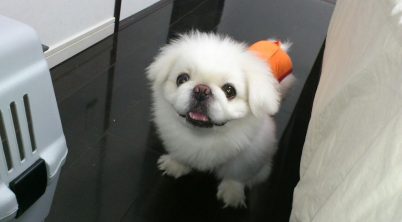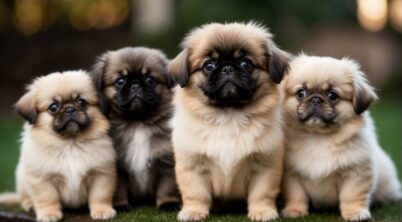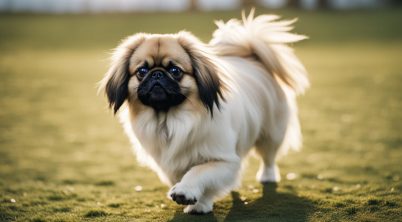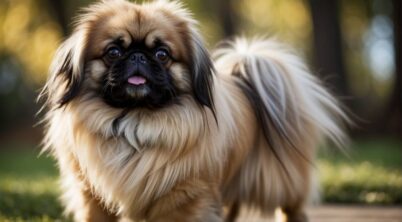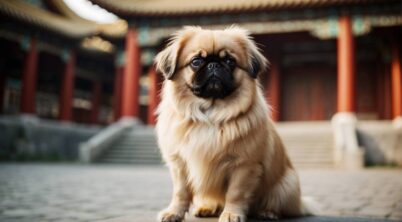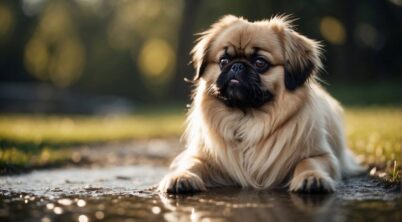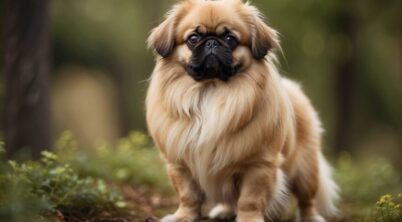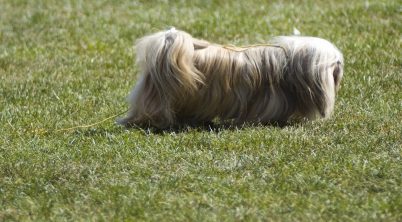The Pekingese, a toy dog breed with ancient Chinese origins, is well-known for its distinct physical traits, among which are its bowed legs. This characteristic gives the dog its notable rolling gait, which is not only a defining breed feature but also contributes to its sturdy nature. Despite their delicate appearance, Pekingese are robust dogs that can handle active play and jumping without issue.
Bowed legs in dogs can be a result of a condition where the legs appear curved outward rather than straight. While it can affect puppies due to developmental issues, adult dogs might also show signs of bow-leggedness through various causes. In the case of the Pekingese, this bowing is a hallmark of their breed standard and not typically indicative of a health problem, thus their physical activity is usually not hindered by this trait.
The Pekingese’s unique leg structure requires special consideration in terms of health and care. While the bow-legged appearance is normal for the breed, it can, in some dogs, lead to or be associated with other issues such as a luxating patella, where the kneecap dislocates from its normal position. Owners of Pekingese dogs should be aware of their pet’s physical characteristics and ensure they receive proper care to maintain their well-being.
Table of Contents
Pekingese Bow Legged
The Pekingese breed is renowned for its distinctive physical trait of short, bowed front legs which are easily noticeable. This breed characteristic relates to their bone structure and is not a defect; rather, it contributes to the breed’s unique appearance and gait.
Characteristics of Bowed Legs:
- Appearance: The legs may curve outward, giving the Pekingese a bowed stance.
- Function: Despite the curvature, Pekingese can move with agility and are capable of quick movements in their environment.
Impact on Movement:
- Gait: The bowed legs contribute to the breed’s characteristic rolling gait.
- Mobility: The structure does not significantly hinder their mobility, although they may not move as swiftly as breeds with straighter legs.
Breeding Standards:
- The American Kennel Club describes the breed as having a lion-like image, partly because of their bowed legs.
- Desirability: In show standards, slightly bowed forelegs are a desirable trait for the Pekingese.
Breeders and enthusiasts must pay close attention to the health and conformity of Pekingese legs to ensure they meet breed standards and do not prevent the dog from a full range of movement. Regular vet check-ups are essential for detecting any health issues early on, which might affect a Pekingese’s legs and overall mobility.
Physical Characteristics
The Pekingese breed is renowned for its distinct physical appearance, which ranges from its small stature to its noticeably bow-legged front legs. This section delves into the specific aspects that define the breed’s physical traits.
Breed Size and Weight
- Height: Typically 6 to 9 inches
- Weight: Usually up to 14 pounds
The Pekingese possesses a compact body with a notable distinction in size between males and females. While both genders may reach similar heights, their weights are an essential consideration for prospective pet owners.
Distinctive Features and Bow-Leggedness
- Coat: Long, thick double coat
- Coat Colors: Varieties include gold, red, sable, black and tan, white, cream, and gray
- Face: Characterized by a flat face and a short snout with wrinkles
Pekingese dogs are often recognized for their distinctive bow-leggedness, particularly in their front legs, which adds to their rolling gait. Their face, known for its flat nature and short snout covered in wrinkles, accentuates the breed’s unique expression. Coupled with their dense double coat that comes in a spectrum of colors, these features make the Pekingese stand out from other breeds.
Behavior and Temperament
The Pekingese breed exhibits a distinctive temperament that balances the loyalty and affection commonly sought in companion dogs with a robust independent streak. Traditionally bred for royalty, these dogs carry themselves with a regal dignity. They tend to form strong bonds with their families, showing fierce loyalty and protective behavior, which can make them excellent watchdogs.
Characterized by their smart and intelligent nature, Pekingese can be good-natured and friendly. However, their independent attitude may lead to stubbornness during training sessions, which requires consistent and patient training techniques. Their ability to learn is high, and they respond well to positive reinforcement methods.
Despite their small size, Pekingese are not always suitable for homes with young children or other pets, including cats. Their tolerance may vary, so socialization from a young age is crucial. They are generally affectionate towards family members but can be reserved or aggressive in the presence of strangers or new animals, which emphasizes their protective nature.
As for their social disposition, Pekingese dogs enjoy companionship but do not require constant attention, aligning with their independent nature. They are quite adaptable in their social interactions but should be socialized early to foster the most amicable behavior toward other dogs and pets.
In summary, Pekingese dogs embody a complex mix of traits: regal yet affectionate, intelligent but stubborn, indeed loyal companions that exude confidence. Their personality requires an owner who appreciates their independent character and is committed to thorough and consistent training.
Health and Care
The Pekingese breed exhibits a unique set of health and care requirements due to its distinctive physical characteristics. Owners should be aware that Pekingese dogs are susceptible to brachycephalic syndrome due to their flat faces, which can lead to breathing difficulties. It’s crucial to monitor their activity levels and avoid overheating during exercise.
Patellar luxation, a condition where the knee cap slips out of place, is also seen in this breed, necessitating prompt veterinary attention to prevent discomfort. Regular vet check-ups can catch early signs of common eye conditions like cataracts or keratoconjunctivitis sicca (dry eye), and progressive retinal atrophy, a degenerative disease that can lead to blindness.
Grooming is integral to a Pekingese’s care. Their long coat requires brushing several times a week to prevent matting and reduce shedding. Special attention should be given to clean their facial folds to avoid fold dermatitis, and routine ear checks will help prevent infections.
Health issues such as hydrocephalus, cleft palate, and distichiasis should be monitored for symptoms. Discussing these conditions with a vet can assist in managing them, and determining if surgery is an appropriate course of action.
A Pekingese’s lifespan generally ranges from 12-14 years, with proper care contributing significantly to their longevity. To maintain good health, a balanced diet and regular grooming, paired with a watchful eye for any changes in health or behavior, are recommended.
Training and Socialization
Training a Pekingese can be a unique challenge due to their independent and sometimes stubborn nature. These dogs were once regarded as royalty in their native China, which may contribute to their self-assured demeanor. Effective training requires consistent discipline and a patient approach. Utilizing positive reinforcement techniques, such as treats and praise, often yields better results than harsh methods.
When it comes to socialization, introducing a Pekingese to various environments, people, and other animals from a young age can be beneficial. This process helps to prevent the development of fear and aggression. Owners should consider:
- Playdates: Small, supervised gatherings with other dogs to promote good canine manners.
- Controlled Exposures: Brief, positive experiences with different stimuli outside the home.
- Training Classes: Group classes that provide structure and social interaction.
Consistent Socialization Tips:
- Start early: Introduce your Pekingese to socialization as early as possible.
- Keep experiences positive: Ensure all social interactions are non-threatening and rewarding.
- Gradual exposure: Increase the complexity of social situations gradually to avoid overwhelming your pet.
Remember, the Pekingese may not always be inclined to please their owner as other breeds might, so adjusting expectations and training methods is key. Regular and gentle discipline, alongside a firm yet loving hand, is the path to a well-rounded and social Pekingese companion.

